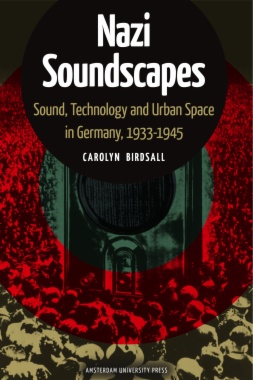Many images of Nazi propaganda are universally recognizable, and symbolize the ways that the National Socialist party manipulated German citizens. What might an examination of the party’s various uses of sound reveal? In Nazi Soundscapes, Carolyn Birdsall offers an in-depth analysis of the cultural significance of sound and new technologies like radio and loudspeaker systems during the rise of the National Socialist party in the 1920s to the end of World War II. Focusing specifically on the urban soundscape of Düsseldorf, this study examines both the production and reception of sound-based propaganda in the public and private spheres. Birdsall provides a vivid account of sound as a key instrument of social control, exclusion, and violence during Nazi Germany, and she makes a persuasive case for the power of sound within modern urban history.
- Contents
- Acknowledgements
- Abbreviations
- Introduction
- Modern Sound and the Metropolis
- Modern Modes of Listening
- Theorising Listening Attention and Sound Technology
- Researching Historical Soundscapes
- 1. Affirmative Resonances in Urban Space
- Auditory Perception and Affirmative Resonance
- Sonic Brawling and Aesthetic Occupations of Public Space
- Publicising Songs, Institutionalising Schlageter
- The Call for National Awakening
- Conclusion
- 2. The Festivalisation of the Everyday
- A Festival for Everyone?
- Radio and the Modern Festival
- Festive Exclusions: The Carnival Heimat
- Anti-Semitic Violence as Festival
- Conclusion
- 3. Mobilising Sound for the Nation at War
- Imagining National Community
- Radio Sounds as National Celebration
- Alarm Sounds as Acoustic Signals
- Suspicious Sounds
- Conclusion
- 4. Cinema as a Gesamtkunstwerk?
- The Gesamtkunstwerk in Cinema
- Acoustic Metaphors: From Symphony to Postcard
- Rhythmic Harmony: Sound as a Controlled Event
- Synchronising the Nazi Era?
- Conclusion
- Afterword: Echoes of the Past
- Notes
- Introduction
- Notes to Chapter 1
- Notes to Chapter 2
- Notes to Chapter 3
- Notes to Chapter 4
- Notes to Afterword
- Bibliography
- Track List
- Track 1 [03:05 mins]
- Track 2 [03:18 mins]
- Track 3 [02:05 mins]
- Track 4 [27:55 mins]
- Track 5 [02:30 mins]
- Track 6 [00:30 mins]
- Index
- Index of Names
- Index of Subjects

